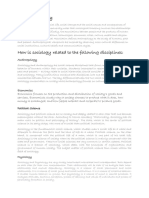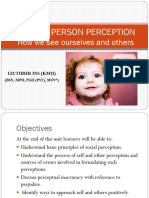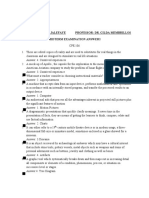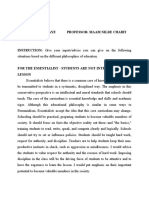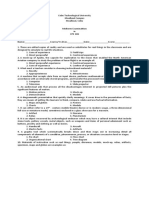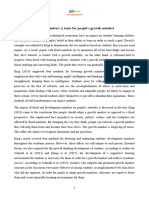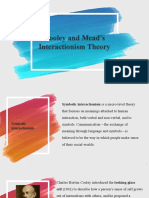0 ratings0% found this document useful (0 votes)
34 viewsBasilisco, Jalefaye Professor: Nerissa Mae Hernandez
Basilisco, Jalefaye Professor: Nerissa Mae Hernandez
Uploaded by
Jalefaye Talledo AbapoInteractionist theory views human behavior as shaped through symbolic communication and interaction within a social and cultural context. People learn symbols, meanings, values, and norms from others which allows them to predict behavior and guide their own actions. However, individuals still make their own interpretations of situations. Deviance occurs when there are failures of communication that lead one to define a situation very differently from others or when anxiety overrides socialization, preventing instrumental understanding between people. The operational reality must be logically consistent, stable over time, and allow people to anticipate others' behaviors for a society to function.
Copyright:
© All Rights Reserved
Available Formats
Download as DOCX, PDF, TXT or read online from Scribd
Basilisco, Jalefaye Professor: Nerissa Mae Hernandez
Basilisco, Jalefaye Professor: Nerissa Mae Hernandez
Uploaded by
Jalefaye Talledo Abapo0 ratings0% found this document useful (0 votes)
34 views5 pagesInteractionist theory views human behavior as shaped through symbolic communication and interaction within a social and cultural context. People learn symbols, meanings, values, and norms from others which allows them to predict behavior and guide their own actions. However, individuals still make their own interpretations of situations. Deviance occurs when there are failures of communication that lead one to define a situation very differently from others or when anxiety overrides socialization, preventing instrumental understanding between people. The operational reality must be logically consistent, stable over time, and allow people to anticipate others' behaviors for a society to function.
Original Description:
4th
Original Title
4th week
Copyright
© © All Rights Reserved
Available Formats
DOCX, PDF, TXT or read online from Scribd
Share this document
Did you find this document useful?
Is this content inappropriate?
Interactionist theory views human behavior as shaped through symbolic communication and interaction within a social and cultural context. People learn symbols, meanings, values, and norms from others which allows them to predict behavior and guide their own actions. However, individuals still make their own interpretations of situations. Deviance occurs when there are failures of communication that lead one to define a situation very differently from others or when anxiety overrides socialization, preventing instrumental understanding between people. The operational reality must be logically consistent, stable over time, and allow people to anticipate others' behaviors for a society to function.
Copyright:
© All Rights Reserved
Available Formats
Download as DOCX, PDF, TXT or read online from Scribd
Download as docx, pdf, or txt
0 ratings0% found this document useful (0 votes)
34 views5 pagesBasilisco, Jalefaye Professor: Nerissa Mae Hernandez
Basilisco, Jalefaye Professor: Nerissa Mae Hernandez
Uploaded by
Jalefaye Talledo AbapoInteractionist theory views human behavior as shaped through symbolic communication and interaction within a social and cultural context. People learn symbols, meanings, values, and norms from others which allows them to predict behavior and guide their own actions. However, individuals still make their own interpretations of situations. Deviance occurs when there are failures of communication that lead one to define a situation very differently from others or when anxiety overrides socialization, preventing instrumental understanding between people. The operational reality must be logically consistent, stable over time, and allow people to anticipate others' behaviors for a society to function.
Copyright:
© All Rights Reserved
Available Formats
Download as DOCX, PDF, TXT or read online from Scribd
Download as docx, pdf, or txt
You are on page 1of 5
BASILISCO, JALEFAYE PROFESSOR: NERISSA MAE HERNANDEZ
EXPLAIN THE INTERACTIONIST THEORIES AND DICUSS THE
METHODS OF COMMUNICATION FOR LEARNING
Much explanation of human behavior is based on assumptions about animal
behavior. Two major contemporary theories, Behaviorism and Freudianism place
major emphasis upon the human being as animal. Many middle-level theories have
no reference to man's distinctive social characteristics. However, social
explanations of behavior do have a heuristic advantage in the study of human
functioning and "social pathology." Symbolic interaction theory operates on the
assumption that man lives in a symbolic environment as well as in a physical
(animal) environment. Symbolic learning emanates from the social processes men
experience. Symbols represent personal meanings, values and associated feelings.
In symbolic communication, one person, seeking to elicit specific behavior from
another, selects a symbol from his "library." The individual believes that he has
chosen the one symbol likely to create the desired behavior. He encodes the
symbol into a "signal" and broadcasts the signal by some means of communication.
He may use speech, writing, or some non-verbal act, and he may not broadcast the
signal perfectly. Then the receiver tries to decode the signal into a symbol, by
retrieving what he thinks are the appropriate meanings and values. If the symbol
has approximately the same meaning and value to both people, the desired action
may occur. Because each person associates the symbol with his own meanings and
values, which are based on his past social learning, much depends on whether both
people have had similar past social learning.
Meaning refers to the way in which people actually use a particular term in
their behavior. A "value" is a learned attraction or repulsion which the individual
relates to a particular symbol or meanning. A "symbol" represents an incipient or
telescoped act in which the later stages (involving elements of both meaning and
value) are implied in the first stage. People learn symbols by interacting with other
people. We can view symbols as having common or shared meanings and values
for most people in a society. This provides the society's "mainstream population"
with a quality of "consensual validation," even though the consensus of
understandings is never complete. Mainstream people share many common norms
and ideals. Norms are direct guides to positive acts or values. Ideals are what the
individual says or believes he would like to do. Norms sometimes coincide with
ideals. Even when ideals do not coincide with norms, they provide guides to
behavior as "remote goals to be reached indirectly." Much adult behavior is learned
from symbolic communication of norms and ideals rather than from direct trial and
error. A culture is an elaborate set of meanings and values tied to symbols and
shared by others in society. Culture guides human behavior. By learning the
culture, men are able to predict each other's behavior most of the time and to gauge
their own behavior to the way they expect others to act. A society is possible only
when common symbols and expectations exist. However, a person does not act in
predeterminable ways even though his actions are purposeful and voluntary. Each
person acts according to his "definition of the situation." He has to interpret other
people's behavior and to make a personal assessment of what is "right and proper"
at the moment. People interpret symbols emotionally as well as intellectually.
When a person makes a rational, substantive "definition of the situation" he also
makes an affective definition of the situation. Ideally, the affective definition deals
primarily with deciphered meanings rather than feelings. The effective system can
operate in one of a number of ways: 1. As a support of the rational analytic system
2. As a diversion from the rational analytic system 3. As opposition to the rational
analytic system 4. As a neutral process .
The way in which the emotional system operates can affect the way a person
decides to behave, the sharpness of his perception, the way he chooses to decode
other people's signals, and the success with which he chooses the symbols he
transmits. So feelings are important because they can augment or impede a person's
encoding and decoding abilities. People also use feelings when they decide what
experiences and interactions to have in the future. To the interactionist, social
organization is the end product of behavior patterns which evolve from people's
attempts to achieve goals. No two people define situations identically, and people
are always re-interpreting their situations, so behavior is always changing.
Interactional "stabilities," which come from a shared culture, give people a
behavioral referent. From the interactionist view, a fully functional person is one
with an adequate repertoire of roles, role behaviors, norms, symbols, and role
equipment. The fully functional person has tested these roles in experiences within
the "mainstream" of societal interaction. In such a "competent" person the variety
of symbols, meanings, values and other role equipment are -deqpzate to secure a
reasonable "fit" in communication with most other persons in his society. This
"actor" has, thereby, earned so complete a sense of security in his role competence
that he is able to balance a sense of personal autonomy with a countervailing sense
of responsibility to others and society. This is what might be described as the most
highly developed level of normative behavior. The deviant, from the interactionist
view, is someone with problems of communication and understanding.
Interactionist theory defines deviance as more than an abnormality on the part of
an individual or individuals. Instead it posits that failures of communication, past
and present, cause the individual to construct a definition of the situation which is
much different from other peoples' definitions of the situation. Such conflict of
"definitions" is a product of the communications and understandings of more than
one person. People become "more than animals" by a process of socialization
which moves through psychogenic, blockage and word stages.
In time a person gains a personal sense of "reality" which is established and
maintained by the consensus of the groups which have meaning to him. "Objective
reality" differs from "consensual reality" in that it is validated by accepted
"experts" over a period of time. Learning occurs primarily in relation to significant
others. The significant other is someone with whom the individual participates in
role reciprocity. These significant others encourage and constrain each other's
behavior through validation or non-validation of each other's acts. Only from a
sense of congruity of meanings with significant others does one derive "social
security." Therefore, the meanings used by significant others have strong affective
or expressive significance, and define the intensity of relationships. The significant
other serves as a model for the individual and helps shape the individual's self-
concept. This self-concept is basic to self-esteem. Developmentally, behavior
precedes meanings and feelings. The individual's ability to communicate with
himself enables him to consciously construct his behavior beyond rote
performance. As the individual observes the behavior of others he arrives at
hypotheses about the motives of others. Motives are a category of meanings.
Continued consideration of other peoples' motives is a necessary process for social
interaction. Interpreting other peoples' behavior helps the individual define who he
is, and where he stands. In a sense, motives can be interpreted as rules or
guidelines of interaction and have been labeled "interactional hypotheses." These
hypotheses can be either instrumental or terminal. Instrumental hypotheses make
possible the mutual exploration of motives for the planning of future interactions.
Terminal hypotheses interpret the behavior, meanings or feelings of others in such
a way that interactions between the self and others are distorted, constrained or
prevented. The individual who is unable to arrive at workable instrumental
hypotheses, or who has learned distorted sets of symbols and meanings, or whose
"creativity" produces meanings and values not understood by others will exhibit
behavior considered deviant by the conventional society. Let us consider the
"operational reality" by which behavior is judged.
The operational reality must enable individuals to predict what others will
do, and to foresee the results of their own actions. It must contain a logical unity
and be simple enough to be useful. It must have a self-correcting capacity. It must
be fairly stable and upheld over time. To understand behavior, we must also
consider anxiety. Anxiety, as defined by Kelley, is the encountering of a situation
for which there is no previous socialization. Anxiety is manifested in stress and
discomfort. As socialization (that which the individual knows and accepts)
interacts with anxiety, a struggle ensues between the two processes. Deviant
behavior occurs when anxiety, rather than socialization, predominates in the
individual's dynamics. When an individual commits behavior which the
operational reality classifies as illegal, immoral, non-conformist or unanticipated,
the behavior is considered deviant. Interactionist societal theory holds that the
nature of the transaction or confrontation is not as important as the meanings which
people attach to their own actions and to the actions of others. A person does not
act in a predeterminable way; his actions are purposeful and voluntary. Thus,
actions are not as much the result of exchange or of coercion, as they are the result
of the individual's differing situation definitions. It should be noted that a residual
effect occurs when a person does not have an adequate repertoire of symbols,
meanings, values and roles necessary to deal with a situation. In such instances he
reverts to animal-like behavior and this is often evident in times of violence,
aggression, or escape. Among the various societal theories, interactionism is
probably singular in its emphasis upon the mutual causality of communication
difficulty and deviance. It takes two or more persons to create communication
ineffectiveness. Functional deviance is a product of ineffective communication.
According to this theory, such problems as non-somatic mental illness, mental
retardation, neurosis, character disorders, and difficult interpersonal relations can
be traced to misperception, misinterpretation, mis-orientation, and inadequately
provided and perceived socialization. (See Blumer 1967, Blumer 1969, Scheff,
Glisinian, Hurwitz, Rose, Nannis, Melther, Dreitzel, Gordon and Gergen, Kuhn,
Thomas, Berger and Lucman, Shibutani 1961, and Shibutani 1970.)
You might also like
- Checklist For Visible LearningDocument4 pagesChecklist For Visible LearningDianaPetre100% (2)
- Symbolic Interactionism TheoryDocument14 pagesSymbolic Interactionism Theoryclaudia1920100% (4)
- Bandura - Spiritual ModelingDocument7 pagesBandura - Spiritual ModelingIndrajaya KusnidaNo ratings yet
- Symbolic Interactionism TheoryDocument11 pagesSymbolic Interactionism TheoryLauriz Dillumas MachonNo ratings yet
- Symbolic Interactionism Theory - NoteDocument7 pagesSymbolic Interactionism Theory - Notepathakastha_666100% (1)
- Module 9 - Symbolic Interactionism SynthesisDocument3 pagesModule 9 - Symbolic Interactionism SynthesisMateo MascardoNo ratings yet
- 3.sysmboic IntertactionismDocument36 pages3.sysmboic IntertactionismMaRvz Nonat MontelibanoNo ratings yet
- INTRODUCTIONDocument25 pagesINTRODUCTION22528013gunveenkaurNo ratings yet
- Internal AssignmentDocument6 pagesInternal AssignmentNishita SinghNo ratings yet
- Blumer - Herbert - Symbolic Interactionism Perspective and Method - Ch. 1+3 - Pp. 1-7+78-89Document19 pagesBlumer - Herbert - Symbolic Interactionism Perspective and Method - Ch. 1+3 - Pp. 1-7+78-89Luca FritzNo ratings yet
- Internal AssignmentDocument5 pagesInternal Assignment210718No ratings yet
- Mead and GoofmanDocument15 pagesMead and GoofmanMadhu BalaNo ratings yet
- Social and Institutional PsychologyDocument8 pagesSocial and Institutional PsychologyScribdTranslationsNo ratings yet
- Lesson 2 ETHICSDocument3 pagesLesson 2 ETHICSGelie AceNo ratings yet
- INTERPRETIVE SOCIOLOGY FinalDocument15 pagesINTERPRETIVE SOCIOLOGY FinalKumar VimalNo ratings yet
- Symbolic Interactionism-Group 3Document6 pagesSymbolic Interactionism-Group 3narvasahannahjuly.bed2023No ratings yet
- Max Weber - Basic Terms (The Fundamental Concepts of Sociology)Document24 pagesMax Weber - Basic Terms (The Fundamental Concepts of Sociology)tmbaum0% (1)
- 4687 Assignment 1Document27 pages4687 Assignment 1Muhammad KhanNo ratings yet
- Social Attitudes and Nonsymbolic Interaction: University of ChicagoDocument10 pagesSocial Attitudes and Nonsymbolic Interaction: University of ChicagoMarcelo SampaioNo ratings yet
- Social Conscience2Document5 pagesSocial Conscience2Abdullah Al MashoodNo ratings yet
- Define Sociology: How Is Sociology Related To The Following DisciplinesDocument13 pagesDefine Sociology: How Is Sociology Related To The Following DisciplinesSheila Divinagracia - EscobedoNo ratings yet
- Introduction To Social PsychologyDocument6 pagesIntroduction To Social PsychologynwokwuikpechukwuNo ratings yet
- Social PsychDocument3 pagesSocial Psychjeyn8150No ratings yet
- What Is Behavior?: 6 Contributing Disciplines To The Organization Behavior Field AreDocument18 pagesWhat Is Behavior?: 6 Contributing Disciplines To The Organization Behavior Field AreVerlyn ElfaNo ratings yet
- Symbolic Interactionism TheoryDocument3 pagesSymbolic Interactionism TheoryWan Farid Wan YusofNo ratings yet
- 1 Debeljuh. The Challenge of EthicsDocument10 pages1 Debeljuh. The Challenge of EthicsScribdTranslationsNo ratings yet
- Burke - Identiy Control TheoryDocument7 pagesBurke - Identiy Control TheoryJenő SándorNo ratings yet
- 11 DISS - Social InteractionismDocument15 pages11 DISS - Social InteractionismRochelle Acala Del RosarioNo ratings yet
- A Sociological Approach To Self and IdentityDocument48 pagesA Sociological Approach To Self and Identityswatcat23No ratings yet
- Becoming A Member of Society Enculturation and SocializationDocument57 pagesBecoming A Member of Society Enculturation and SocializationBLASORCA, Lancine Aslee R.No ratings yet
- Fss Shashank JainDocument5 pagesFss Shashank JainShashank JainNo ratings yet
- DISSDocument13 pagesDISSLyka Celine De JesusNo ratings yet
- The Social Animal: Navigating The Complex World Of Human RelationshipsFrom EverandThe Social Animal: Navigating The Complex World Of Human RelationshipsNo ratings yet
- Theoretical Approaches in SociologyDocument14 pagesTheoretical Approaches in SociologyAiman Nazeer AhmedNo ratings yet
- Theory and Perspective-1Document37 pagesTheory and Perspective-1Zeeshan MeharNo ratings yet
- Person PerceptionDocument37 pagesPerson Perceptionasifkhanab78No ratings yet
- Recent1 Final ReportDocument37 pagesRecent1 Final Reportdelia lanibaNo ratings yet
- The Concept of Social PsychologyDocument3 pagesThe Concept of Social Psychologyfarisya zakiNo ratings yet
- 6 Kingfisher and Skylark ST., Zabarte Subd., Brgy. Kaligayahan, Novaliches, Quezon CityDocument4 pages6 Kingfisher and Skylark ST., Zabarte Subd., Brgy. Kaligayahan, Novaliches, Quezon CityImyourbitchNo ratings yet
- Conversation Analysis: 1. Learning ObjectivesDocument53 pagesConversation Analysis: 1. Learning Objectiveselvira lindaNo ratings yet
- Edgar L. Guanzon Reaction PaperDocument6 pagesEdgar L. Guanzon Reaction PaperRis Leahcim YohomalcNo ratings yet
- Textual Notes - Social ProcessesDocument46 pagesTextual Notes - Social ProcessesSandesh WaghmareNo ratings yet
- Chapter IIDocument17 pagesChapter IIJoshita SinghNo ratings yet
- Attitude - Human Relations in NursingDocument36 pagesAttitude - Human Relations in NursingRonan Ang100% (1)
- Self From Sociological and Anthropological PerspectiveDocument11 pagesSelf From Sociological and Anthropological PerspectiveMJ CentenoNo ratings yet
- QUESTION-Examine The Concept of Institution With Help of IllustrationsDocument3 pagesQUESTION-Examine The Concept of Institution With Help of IllustrationsashiyaNo ratings yet
- Unit 1-Introduction To Social Psychology What Is Social Psychology?Document51 pagesUnit 1-Introduction To Social Psychology What Is Social Psychology?Ananta ChaliseNo ratings yet
- 91-97 Communication Charm and ShynessDocument7 pages91-97 Communication Charm and ShynessOmidNo ratings yet
- Social Psychology (PDFDrive)Document190 pagesSocial Psychology (PDFDrive)MoijeNo ratings yet
- Symbolic InteractionismDocument7 pagesSymbolic InteractionismTARUSHI KAURNo ratings yet
- Prelim EthicsDocument19 pagesPrelim EthicsSoojuu sojuuNo ratings yet
- Human Behavior and Interpersonal CommDocument11 pagesHuman Behavior and Interpersonal CommOwolabi PetersNo ratings yet
- 1.3D The Symbolic Interactionist PerspectiveDocument2 pages1.3D The Symbolic Interactionist PerspectiveJenevive Lagrimas CasundoNo ratings yet
- Differences - That Is, The Range of Different Styles of Thinking, Feeling and Acting. Just As HumanDocument4 pagesDifferences - That Is, The Range of Different Styles of Thinking, Feeling and Acting. Just As HumandeliejoyceNo ratings yet
- Individual and Society NotesDocument23 pagesIndividual and Society Noteskb6360482966No ratings yet
- Rules For Sociological MethodDocument8 pagesRules For Sociological MethodIvneet VohraNo ratings yet
- Symbolic Interactionism Is A Sociological Perspective That Focuses On The MicroDocument40 pagesSymbolic Interactionism Is A Sociological Perspective That Focuses On The MicroegentialexaNo ratings yet
- Social PerceptionDocument16 pagesSocial PerceptionSadhika GuptaNo ratings yet
- Student: Basilisco, Jalefaye Professor: Dr. Gilda Membrillos Midterm Examination AnswersDocument3 pagesStudent: Basilisco, Jalefaye Professor: Dr. Gilda Membrillos Midterm Examination AnswersJalefaye Talledo AbapoNo ratings yet
- Basilisco Semi Detailed Lesson PlanDocument7 pagesBasilisco Semi Detailed Lesson PlanJalefaye Talledo AbapoNo ratings yet
- Cebu Technological University Moalboal Campus Moalboal, CebuDocument2 pagesCebu Technological University Moalboal Campus Moalboal, CebuJalefaye Talledo AbapoNo ratings yet
- Basilisco, Jalefaye Professor: Maam Nilde ChabitDocument15 pagesBasilisco, Jalefaye Professor: Maam Nilde ChabitJalefaye Talledo AbapoNo ratings yet
- Basilisco, Jalefaye Professor: Maam Nerissa EscabasDocument3 pagesBasilisco, Jalefaye Professor: Maam Nerissa EscabasJalefaye Talledo Abapo100% (3)
- 2nd Activity Maam ChabitDocument5 pages2nd Activity Maam ChabitJalefaye Talledo Abapo100% (1)
- Basilisco, Jalefaye Professor: Nerissa Mae HernandezDocument3 pagesBasilisco, Jalefaye Professor: Nerissa Mae HernandezJalefaye Talledo AbapoNo ratings yet
- Final Principles of TeachinggDocument9 pagesFinal Principles of TeachinggJalefaye Talledo AbapoNo ratings yet
- Philippine EducationDocument2 pagesPhilippine EducationJalefaye Talledo AbapoNo ratings yet
- Lesson Plan Semi DetailedDocument3 pagesLesson Plan Semi DetailedJalefaye Talledo Abapo100% (3)
- Preparation of Curriculum ExamsDocument9 pagesPreparation of Curriculum ExamsJalefaye Talledo AbapoNo ratings yet
- Lesson Plan BriefDocument6 pagesLesson Plan BriefJalefaye Talledo AbapoNo ratings yet
- Visual AidsDocument1 pageVisual AidsJalefaye Talledo AbapoNo ratings yet
- Basilisco, Jalefaye Professor: Maam Nerissa Mae HernandezDocument5 pagesBasilisco, Jalefaye Professor: Maam Nerissa Mae HernandezJalefaye Talledo AbapoNo ratings yet
- Criminalistics Review QuestionsDocument100 pagesCriminalistics Review QuestionsJalefaye Talledo AbapoNo ratings yet
- The Honorable Members of The Sangguniang Panlalawigan Committee ReportDocument6 pagesThe Honorable Members of The Sangguniang Panlalawigan Committee ReportJalefaye Talledo AbapoNo ratings yet
- Office of The Provincial Board: RD ND RDDocument3 pagesOffice of The Provincial Board: RD ND RDJalefaye Talledo AbapoNo ratings yet
- Example Only: List of Needed Vas and Ims For TeachingDocument16 pagesExample Only: List of Needed Vas and Ims For TeachingJalefaye Talledo AbapoNo ratings yet
- BasiliscoDocument12 pagesBasiliscoJalefaye Talledo AbapoNo ratings yet
- Office of The Provincial Board: RD ND RDDocument3 pagesOffice of The Provincial Board: RD ND RDJalefaye Talledo AbapoNo ratings yet
- Page 1 of 2Document2 pagesPage 1 of 2Jalefaye Talledo AbapoNo ratings yet
- Page 1 of 2Document2 pagesPage 1 of 2Jalefaye Talledo AbapoNo ratings yet
- Cheating Recovery ToolkitDocument23 pagesCheating Recovery ToolkitSuzie Smithson HastonNo ratings yet
- Work Immersion AppraisalDocument4 pagesWork Immersion AppraisalScarlette Beauty EnriquezNo ratings yet
- Bản Sao Bản Sao Của ERW421 - Assignment 1 - Nhan Thị Tuyết HiênDocument2 pagesBản Sao Bản Sao Của ERW421 - Assignment 1 - Nhan Thị Tuyết Hiênbinh081103No ratings yet
- Group DiscussionDocument19 pagesGroup DiscussionsagarNo ratings yet
- Section 1 Questions 1-5Document4 pagesSection 1 Questions 1-5jcgxchchNo ratings yet
- Jacques Lacan Emilio Granzotto InterviewDocument9 pagesJacques Lacan Emilio Granzotto InterviewAkbar HassanNo ratings yet
- Scope of The StudyDocument3 pagesScope of The StudyVaibhav SharmaNo ratings yet
- CPDP AssingmentDocument26 pagesCPDP AssingmentPatel KashyapNo ratings yet
- Effects of Sugar Consumption oDocument13 pagesEffects of Sugar Consumption osaya amirazNo ratings yet
- "Behaviour Based Safety": Conducted byDocument39 pages"Behaviour Based Safety": Conducted bypraveenNo ratings yet
- Resume 2020Document3 pagesResume 2020api-427644091No ratings yet
- Train The Trainer Questionnaire People Solve FormatDocument6 pagesTrain The Trainer Questionnaire People Solve FormattotoafifiNo ratings yet
- Research ThesisDocument17 pagesResearch ThesisBODAÑO, JENHIEL IAN B.No ratings yet
- Virtue EthicsDocument13 pagesVirtue EthicsSaji Jimeno100% (1)
- BolanderDocument2 pagesBolanderapi-454723840No ratings yet
- Relationship Psychological Therapy 1Document7 pagesRelationship Psychological Therapy 1Isaac OmwengaNo ratings yet
- Brilliant SellingDocument16 pagesBrilliant Sellinggoran_sandev100% (1)
- NyayaDocument38 pagesNyayaRaghu YadavNo ratings yet
- PerseFmod 1 SELF AWARENESS PDFDocument5 pagesPerseFmod 1 SELF AWARENESS PDFLemwell BiloNo ratings yet
- AttitudeDocument9 pagesAttitudegodspower brunoNo ratings yet
- Teaching Strategies Applying 21 CenturyDocument7 pagesTeaching Strategies Applying 21 CenturyebellaamayrahaisyahNo ratings yet
- Group PresentationDocument1 pageGroup PresentationJunna Marie DiosesNo ratings yet
- Psychological Mechanism of The Speech ProcessDocument14 pagesPsychological Mechanism of The Speech ProcessMariia BilovodNo ratings yet
- Job SatisfactionDocument10 pagesJob SatisfactionRojanie Estuita100% (1)
- Assessment of Learning 1 Educ 8 BSNED BECED BEeDDocument25 pagesAssessment of Learning 1 Educ 8 BSNED BECED BEeDMerrilyn carinoNo ratings yet
- Teza Doctorat WengerDocument255 pagesTeza Doctorat WengerLoredana ManasiaNo ratings yet
- Late SittingDocument4 pagesLate SittingEhtesham ul HaqNo ratings yet
- Spoken Word RubricDocument2 pagesSpoken Word RubricJames Fulgencio100% (1)
- Cooley and Mead's Interactionism TheoryDocument11 pagesCooley and Mead's Interactionism TheoryLynette AndayNo ratings yet




















